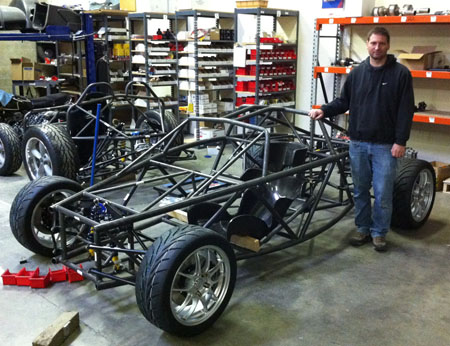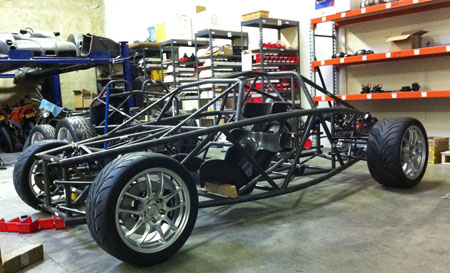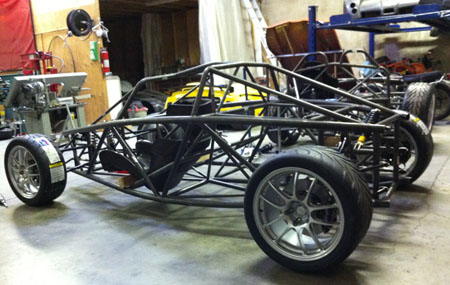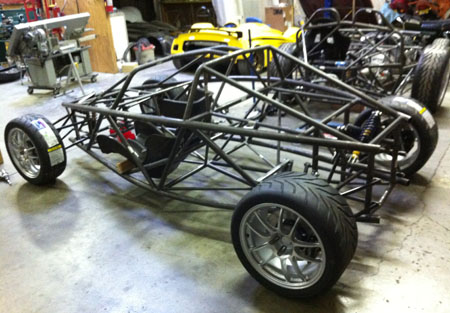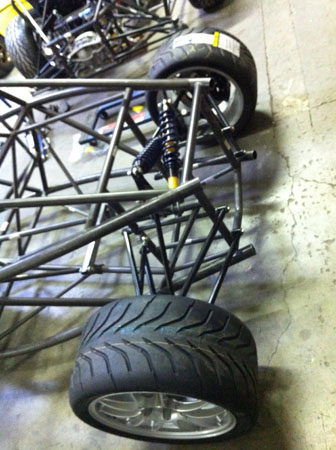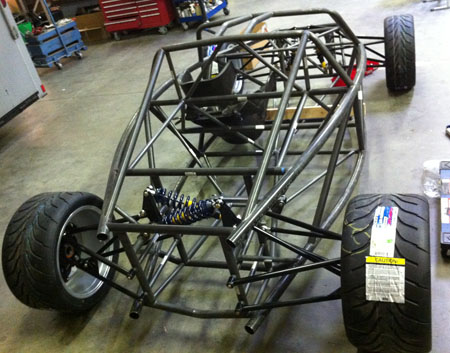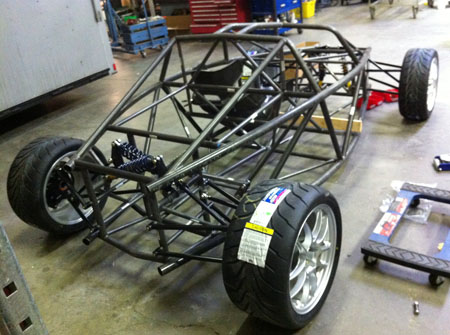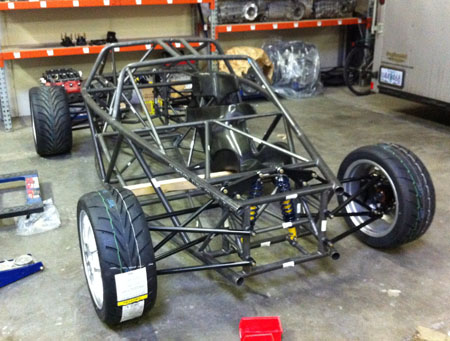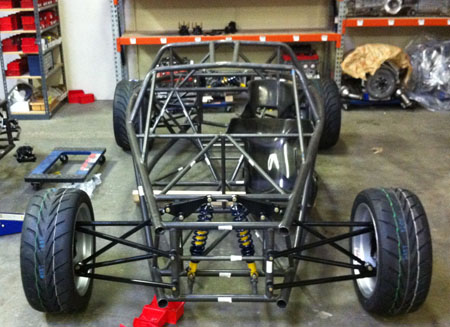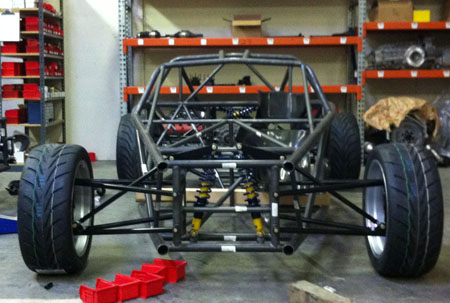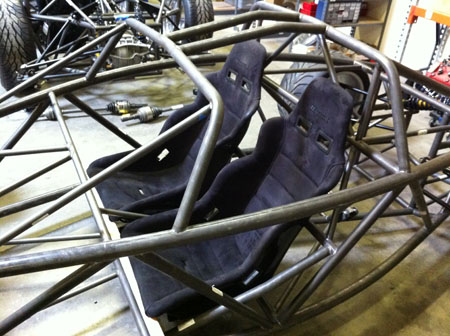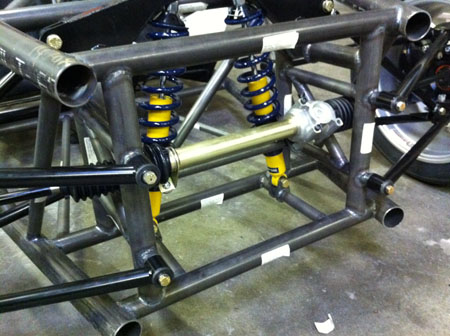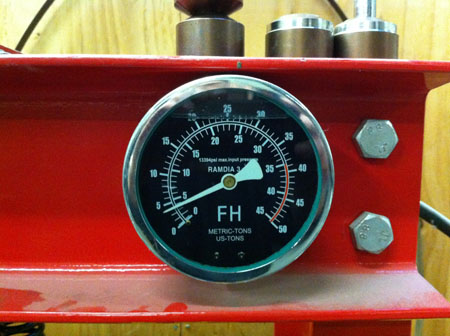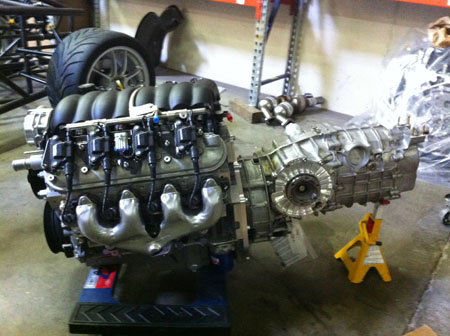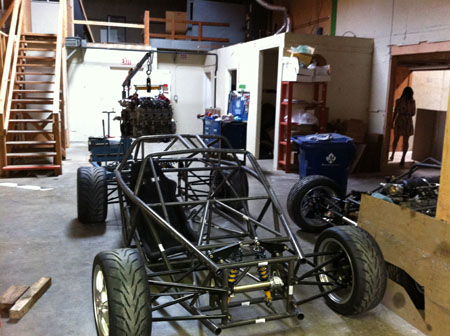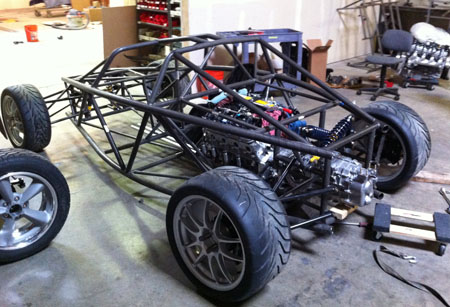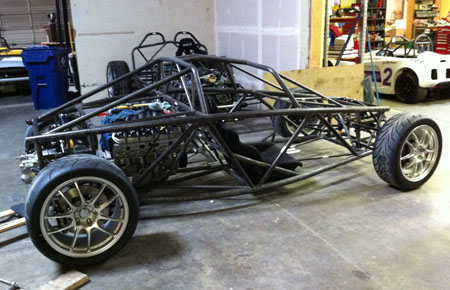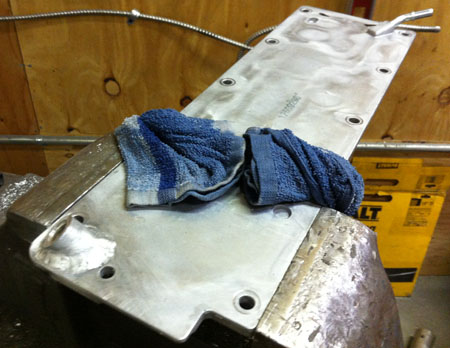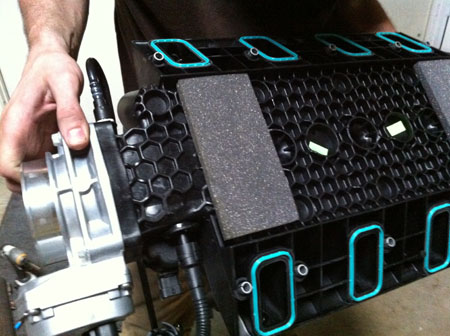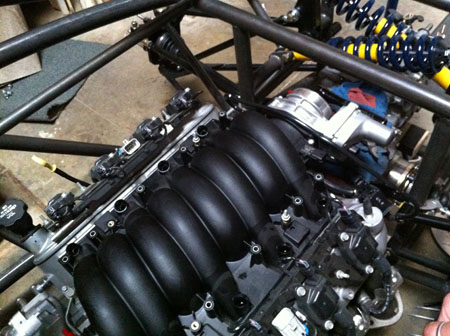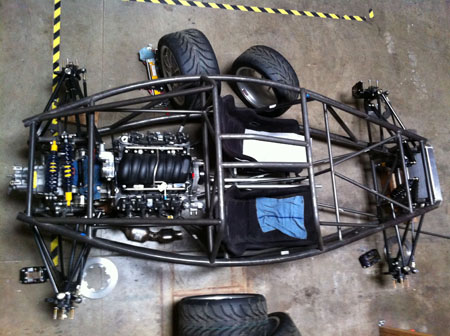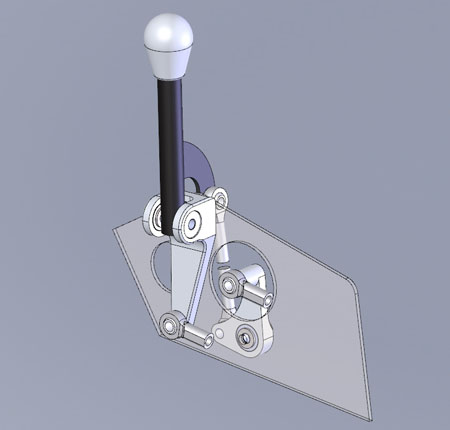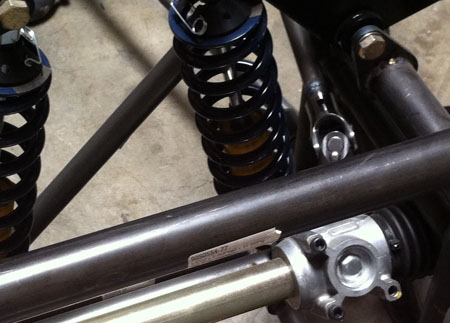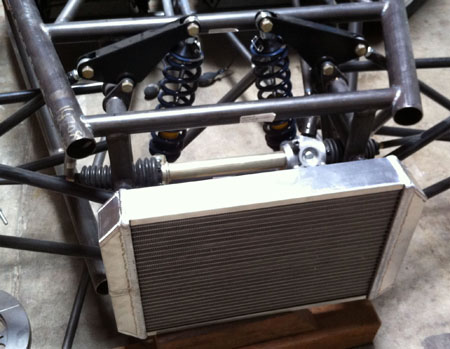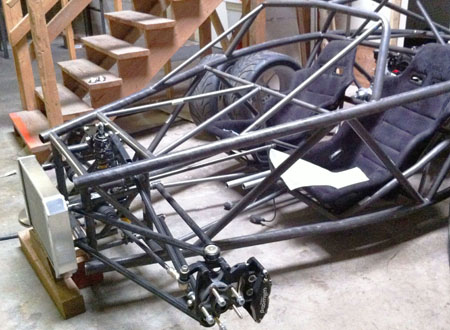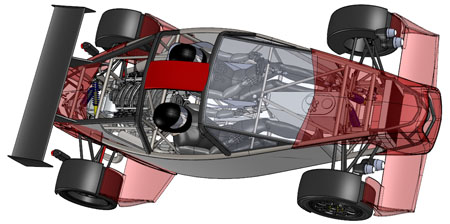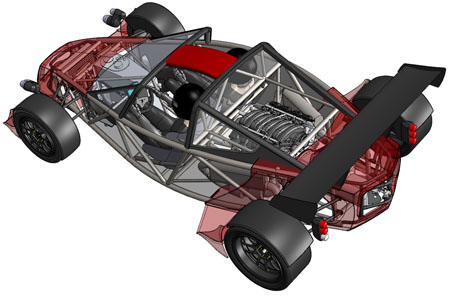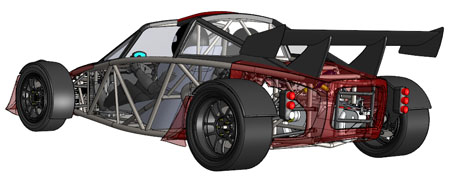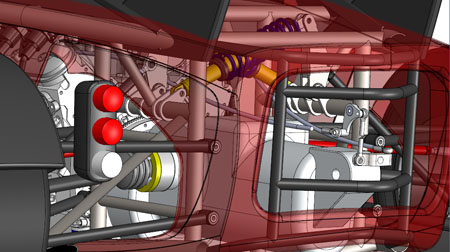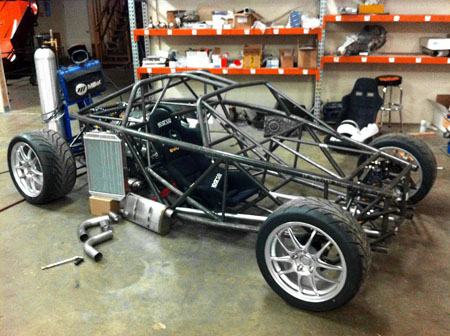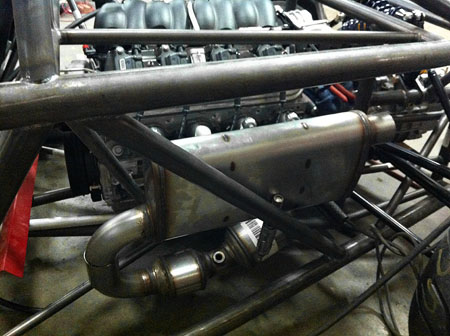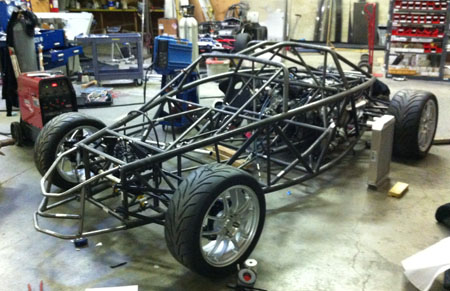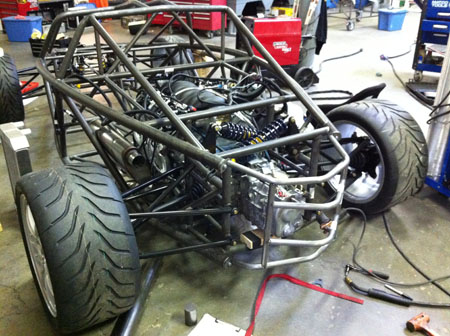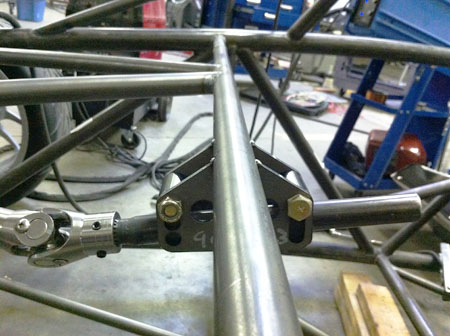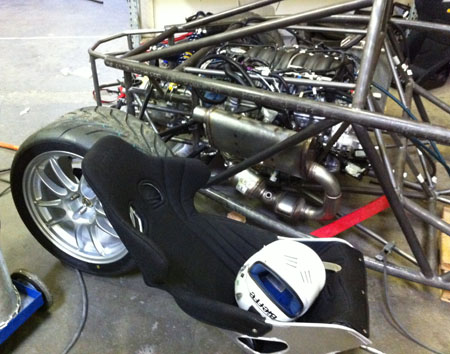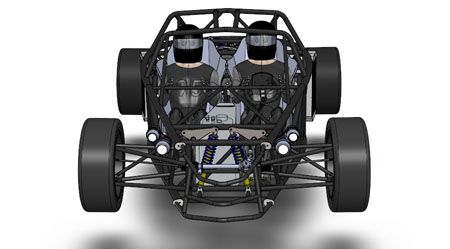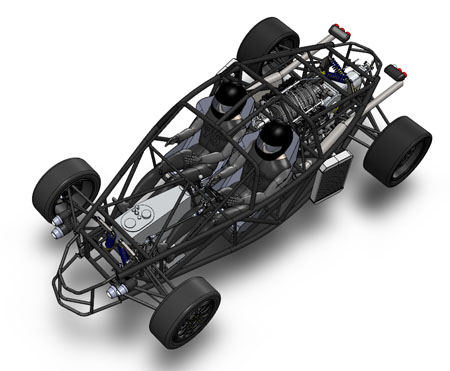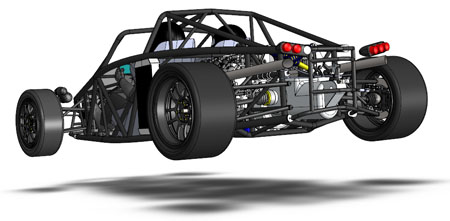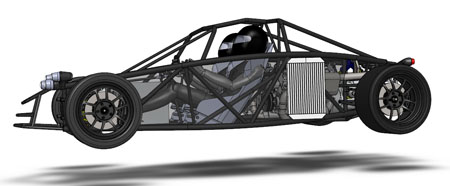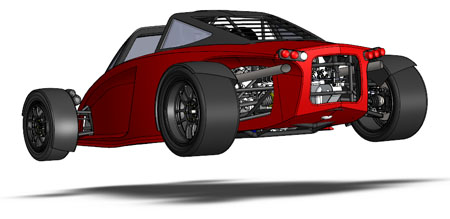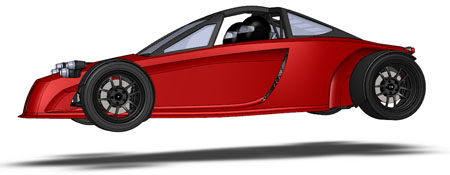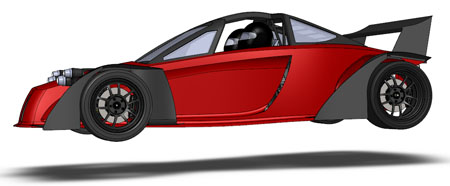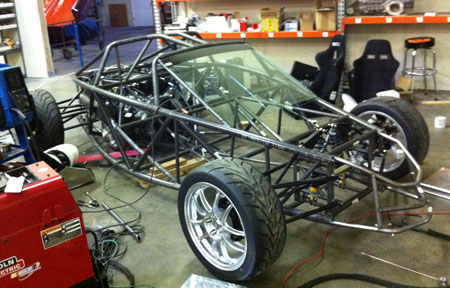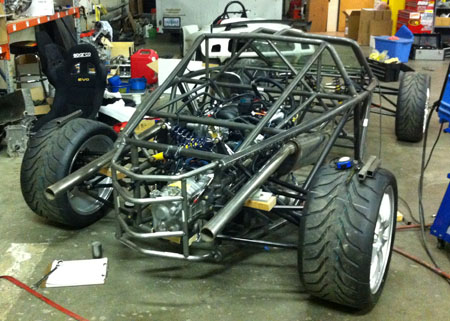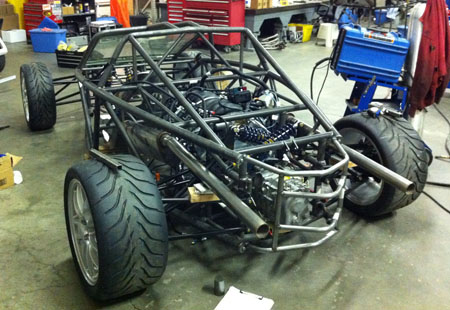|
03/21/12 Another milestone - the D2 is now sitting on its own wheels. I'm really looking forward to driving this one! Just keep thinking '430 horsepower' when you look at the pictures ;)
03/28/12 Work continues... Test-fitting another pair of seats. Also looking at additional alternatives.
With the seats in it's easier to visualize all the other systems and parts, including interior panels. I now have a modified approach from what I was going to do before I saw this in the flesh. Also, things we're doing for the Pikes Peak car are influencing this design (and vice versa). In some ways it's very good to have a number of simultaneous and diverse projects. They cross-pollinate well :) One thing I kept meaning to do is test the suspension arm mounts. The design (actually quite similar to how some production car suspensions attach, the Corvette for example) may look a bit iffy. I did some calculations at the early stages and they showed the fitting should fail at about 6,000 lbs - keep in mind the entire car weighs 1,600 lbs.
You do want a 'safety valve' in the suspension, something that will break in an impact without bending the frame. The trick is to make sure it doesn't break in normal use, even if 'normal' involves hitting an apex curb under 2g load. So I came up with a test fixture using our hydraulic press.
The press has a force gage that seems to be in the ballpark accuracy-wise. It can definitely tell us if the design is close to where it needs to be or way off. A bit of pressure and the part does yield...
It did so at 4 tons (8,000 lbs) and did not completely break but rather it yielded. This is very encouraging. As a backup plan I had been thinking of various ways to reinforce the mounts if the test was not successful. Now it's one less thing I have to worry about. The design is shared with the Stiletto so everything here applies to that car as well. Two birds with one press. Now on to the multitude of other things. Engine/transmission install is next for the D2. 04/16/12 Currently waiting on some bits and pieces to be fabricated before more visible progress can happen on the D2, but we did assemble an engine to its transmission and the various adapters.
It is possible but rather awkward to install the engine/gearbox as a unit so the official way will be to get the engine in first and then bolt the box to it. Fortunately the open frame allows great access to just about anything you'd want to do maintenance-wise so engine removal is going to be a rather infrequent thing (never, for most people). If someone needs to service the gearbox or the clutch the engine can stay in the chassis while it's done. We are now actively transitioning from the development phase of our business to full-on production. We've recently lined up some additional resources and things should move pretty quickly going forward. Next 12 weeks are going to be crazy! :) Not that the previous 200 haven't been... 07/05/12 With Pikes Peak race postponed we got a lot of questions about whether we are going to contiune development of the D4PPS. Yes, the race is very important to us and we do have some obvious improvements to make which will better our chances and so the development will continue... But it's not the only thing we do as a company. For example we have three D2s to deliver to some VERY patient customers (and Stiletto, too, but that's another blog). It's high time we made some progress on the other projects. And so we have.
I really like the all-engine 'posture' of the D2. Yes, this is exactly what I envisioned when I added it to our list of designs to develop. Size of an Exige, 400 lbs (25%) less weight, twice the power and torque. Just about right. Getting both the first D2 and the Stiletto running are among the top priorities going forward. Much work needs to be done and true to our core philosphy of leveraging technology across several designs, work on one will directly apply to the other. So we have now test-fitted the engine and transmission in the first D2. Getting the wiring, controls, exhaust and other systems together is next along with a myriad other tasks. Stiletto will get its own blog updates shortly. I eagerly look forward to driving these beasts so that is added motivation as well. 09/06/12 Some tangible progress on the D2. Much of the design work lately has taken place in my head (it's all a part of the process) and some in CAD. There is also a list of concrete steps that we need to take to get to a drivable car. One of the items on the list is turning the intake manifold around so that the airbox can live behind the engine, where there is (more) room for it. The procedure is well documented on the internet by several bloggers. The issue is relocating the oil pressure sensor that normally prevents flipping the intake by sticking out vertically from a spacer plate, and interfering with the throttle body. Some solutions are better than others. For ours, Tristan has figured out exact angle that the sensor has to be at while still fitting in more or less the original location. Some grinding, some welding and we're one step further along.
To say that the LS3 is a highly engineered device would be a vast understatement. It is obvious that hundreds of engineers spent thousands of hours on every little bracket and gasket. Good for us.
Controls are next - I'm finishing up the CAD on a fully custom pedal set (which will also be available as an item on our site eventually). Also the steering, shifter and other bits. 09/24/12 This is the stage of the project where a lot of the detail work takes place. Sometimes evolving a particular system to its logical conclusion forces a significant redesign of some others. It's an iterative process.
For example, the shifter mechanism is now on its 5th iteration and looking near-final. The challenge is to take up as little space between the seats as possible and still provide a direct feel. I've looked at several cable routing options which are a challenge. Any bend in the cable introduces both friction and play in the mechanism so the bends have to be minimized and made with as large a radius as possible. The details of the linkage must change accordingly.
To keep things as precise as possible all the pivots are double roller bearings. This goes for the pedal assembly too... Again the challenge is space so the master cylinders are under the driver's heels. This is something I've already done on the D4 and D1 using off-the-shelf parts but here I'm using custom cylinder housings with Wilwood internals to make it more compact - the top of the base plate is only 1.5" off the floor.
All pedals have adjustable stops and integral return springs. The steering column is now built but of course in moving the pedals around I've decided that we need more vertical clearance for drivers with big feet so another U-joint will be added to facilitate that. The clearances are tight as always but it all fits.
Other details have to do with the frame itself - I've added some tubes on the sides and front of the cockpit for better intrusion protection. Below are the before and after pictures.
The additional tubes are set up so that for customers wanting to have the 'exoskeletal' look they won't be visible, leaving the styling cleaner. Radiator mounts and front/rear crush structures are next as far as the frame goes. The radiator is a high-efficiency dual pass unit (custom, of course) and will be fully ducted to make the best use of available space. Based on the experience with the v8 Atom which has similar power output the radiator should be adequate, but I have backup options in case testing proves otherwise. I'm also strongly considering moving the fuel cell from in front of the engine to between occupants. Although this would eliminate the low-cost option of a baffled aluminum tank and require the use of a proper bladder-type aluminum enclosed cell, I think it is a better solution.
The cell capacity would be about 12 gallons and all of it would be usable without starvation in turns due to the vertical orientation. Filler cap would be on top of the nose, ahead of the windshield. This location protects the fuel cell much better and keeps it away from the engine and exhaust. This aspect will be finalized in the next couple days because I have to place the order with FuelSafe. 9/28/2012 There is a lot of back-and-forth between the real and the virtual now. To finalize the dimensions of the fuel cell I spent a lot of time tweaking the Solidworks files and equally as much time sitting in both the right and left seat with cardboard boxes stacked next to my legs, as well as measuring all the shoes I could find. M would occasionally walk by me sitting in the car and ask me what I'm doing. Designing, of course - she should know by now. And she does. Lots of little details from shifter to pedal placement to exact fuel cell dimensions. My lead customers keep asking for more fuel capacity. 15 gallons is the most I could squeeze in and I think that should be OK. The cell is now out for quotes. Got a lot of stainless and aluminum tubing and mandrel bends today. Exhaust and plumbing are being made. Tristan is ready to weld the left-side exhaust together, pictures will come when it's done. For now here are a couple from the virtual side of things:
The shifter linkage in particular has been quite a challenge. I think the shifter design is now finished except for the rear mounting bracket (which is also the transmission mount). The iterations have been numerous and yes I have considered rods, U-joints, bellcranks, cables and pretty much all combinations of the above. The one I settled on makes the most sense to me in this particular chassis. I've verified the cable routing using pieces or rubber hose and it should work pretty well.
I also finalized the standard seat choice and ordered the first two. Seat (and belt) mounting is now worked out which resulted in a couple new tubes being added to the chassis. And so it goes. There are many people very anxious to see the first D2 run. I'm definitely one of them. By the way there are many smaller news items that don't necessarily get a blog post of their own that are noted on our Facebook page. If you don't follow it yet, check it out. 10/01/12 Sometimes staring at things long enough (and letting other people's comments sink in) can lead to solutions. One item is the cooling - I am fairly confident that for the standard LS3 the radiator is quite adequate. But while messing with the seats I became acutely aware of how close the hot tubes would be running to the occupants. And, every new inquiry I get seems to up the ante. People are talking 700+ hp and heavy track use. This is of course what I anticipated (and hoped for) but I finally had to admit that I need to design for this from the beginning and not put off the inevitable. So, the radiator capacity got doubled by taking two of the existing radiators and moving one each to the sides of the car. Obviously scoops will direct the air and the location is actually pretty efficient - this is where the F1 guys put their radiators. No more coolant in the cockpit either.
There are many other benefits as well. The fuel cell can now sit almost 3" lower. The nose is open to house a full size battery where it will help the weight distribution. The oil cooler now goes in the nose which requires far less airflow and therefore opens up lots of new styling possibilities. And, since I already have several of the radiators onhand using two per car doesn't slow me down. Cost impact is very modest and if someone wants to use just one there's always that option. Tristan has been hard at work fabricating the exhaust. In CAD it all fit quite nicely but in real world with large radius bends, overlaps and the need to align stainless steel segments accurately for welding meant that the low exit pipes are not practical. So we flipped the mufflers and now the tailpipes will come out the back. They can still be dropped down low aft of suspension if desired.
I've mentioned the seats. Just when I thought I had it figured out Tristan had to go and express an opinion that the arrangement was not ideal. Hmm, OK, I can kind of see that but it was the best I had come up with so far and it wasn't for the lack of trying. So I thought about it some more. It would be really cool if the storage space behind the seats could be accessed by tilting them forward. This way there's actually room in the car for a couple helmets and some small items too. I've also identified the most promising standard seat candidates (they come in widths from 14" to 18") and ordered a pair of 15" wide ones which will be the most common size. Accommodating the variety of sizes in the mounts is part of the challenge.
Tilting the seats is the only practical way to get a helmet in there. So, a lot more staring at things while I spin them in my in-head 3D simulator. Then a bit of searching the Internets and bingo, I have a solution. It's still not in CAD but will be shortly. Bottom line is yes you'll be able to tilt the seats forward to access the space behind them and the seats will latch down securely. The firewall will be on the engine side of the storage compartment and insulation will keep things from getting too hot. Speaking of CAD, I just received our brand-new copy of SolidWorks Flow Simulation. This gives us real CFD capabilities and once the D2 styling is updated to reflect the recent changes it will be run through some evaluations. I'm going to use the Pikes Peak car and the strain gage data we've gathered to fine-tune the models and setups first. Once we have reasonable correlation between CFD and real world we'll be able to make a lot of progress quickly. This is going to be fun! A massive learning curve too which is why I'm going to put this off until the D2 is a drivable chassis. In the meantime, a lot of sheetmetal parts and brackets are being ordered and I'm starting to dig into the realities of a windshield again. Stay tuned. 10/11/12 A lot has been done since the last update. Here's some of it: The front and rear crush structures are welded up. They bolt on to the main frame and are easily replaced. This really makes it look a lot more like a complete car. By our standards it's BIG :) Roughly same length and height as an Exige but a foot wider at the back and 8" more wheelbase. Of course I couldn't resist putting it on the scales. As pictured below - with engine (full of oil!), gearbox, axles, exhaust, suspension, wheels/tires and wiring harness it's 1,284 lbs. Which means I can add about 320 lbs worth of stuff and still hit my 1,600 lb dry weight target. That's about what it'll take so it should be close. Not bad for a 6.2L V8 two-seater with 430hp and 450lb-ft torque :)
Steering linkage is also in. Note the height/tilt adjustment provisions in the second picture. The linkage uses 3 U-joints to keep angularity within reason and to provide clearance for larger feet. All the steering supports are sealed needle roller bearings.
Among other items - the seats are here (will probably powdercoat the aluminum black when all is done), so are the shift cables. The work on the wiring harness has started. And many other things...
10/16/12 Design is an iterative process. There are some formal theories on 'top-down' vs 'bottom-up' but the reality is far less academic and much more opportunistic. You work on some parts for a while, maybe because of leadtimes, maybe because some new information just became available, or just because inspiration happened to take a particular turn today. Changes in one area affect lots of other bits so you propagate them throughout. Sometimes what seems like a cool solution at first turns out much less so once all the affected systems are updated. So you go back and redo... The D2 bodywork is a perfect example. There's the styling aspect of it, which is rather subjective. And then there's all the stuff underneath that has to fit and work. Moving radiators to the middle of the car (see earlier posts) is a neat solution to a number of packaging issues. But it means the bodywork has to be redone to work with the change. It takes a fair bit of effort to arrive at something that looks halfway decent. I'm now on version 'O', as in letter of the alphabet. Yes that means there were 'A' through 'N' before it, and that's just the major revisions. Below are some pictures of what the car looks like in CAD now. First just the chassis, then the 'base' configuration and then the optional aero package.
No, the nose is not final. None of it is really. For the moment the bodywork is just being updated enough to see if the structural changes can be reasonably accommodated. After the bare chassis is a running drivable machine the bodywork will go through a lot of CFD analysis as well as staring at it from an appearance standpoint. I fully expect to run out of letters for the revs :) One structural issue is the windshield. I actually attempted to cut down a Prius windshield as a test. Despite the profound lack of success much was learned in the process. First, windshield cutting is not a practical approach if you want to make more than one car. This is because it would take about 5 windshields and lots of time, effort and patience to produce one good one. But I also learned that when cut down to the size usable on this car the Prius glass is essentially flat anyway so initially just getting a flat windshield made will do fine. That is far easier than the curved stuff and can always be upgraded down the line. In the meantime the butchered piece of glass serves as a visual reference which is good enough for now.
I've been doing a lot of detail CAD on brackets and such, and Tristan has been turning virtual parts into real ones. Although sometimes staring at a partially completed physical part it's much easier to visualize how the surroundings need to be. The rest of the exhaust is one of the more visible examples of this. Tristan built the pipes where they need to go and we figured out the mounts from there. After they're tested in real life I'll put them into SolidWorks. It's an iterative process.
Intake is next. The packaging is tight (would you expect any different from me?) but it looks like it might work. One issue is keeping the MAF sensor happy and I've been getting lots of good advice on that. The factory sensor has to be used to maintain 50-state emissions compliance of the e-rod kit so getting rid of it is not an option. I'm pretty confident I have a solution that will work. We'll see.
|
